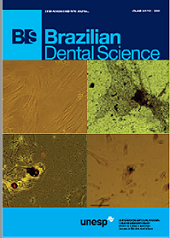Comparative evaluation of the effect of various irrigants and dry canal on electronic apex locators in locating simulated root perforations: an in vitro study
DOI:
https://doi.org/10.14295/bds.2020.v23i1.1856Resumo
Objective: this study aimed to evaluate the effects of irrigants and dry canal on the accuracy of electronic apex locator (EAL) in locating simulated root perforations. Material and methods: twenty singlerooted, mandibular premolars were decoronated at CEJ, and the contents were removed with a barbed broach. The canals were instrumented up to a size of 15 K-file. The roots were artificially perforated at 4 mm from the anatomic apex. The actual length (AL) up to the perforation site was determined. The electronic length (EL) of perforations was obtained by Root ZX mini and iRoot in the dry canal and in the presence of 5.2% NaOCl, SmearOff, and 0.9% sodium chloride using a size 20 K-file. The differences between the EL and AL of the perforations were calculated. Statistical analyses using Friedman and Wilcoxon signed-rank tests were used to analyse the data with the level of significance set at p < 0.05. Results: there were significant differences in different canal conditions with both Root ZX mini and i Root. Measurements in dry canals were significantly longer for both apex locators (p < 0.05). Measurements with NaOCl were significantly shorter for both apex locators (p < 0.05). Both apex locators produced significantly accurate values for Saline and Smear OFF (p < 0.05). Conclusions: in this study, both Root ZX mini and i Root were affected by different canal conditions. The most accurate measurements were seen in the presence of saline and SmearOFF.
KEYWORDS
Electronic apex locator; I Root; Perforation; Root ZX mini; SmearOFF; Sodium hypochlorite; Saline.
Keywords: Electronic apex locator, i Root, perforation, Root ZX mini, SmearOFF, sodium hypochlorite, saline
Downloads
Downloads
Arquivos adicionais
Publicado
Como Citar
Edição
Seção
Licença
TRANSFERÊNCIA DE DIREITOS AUTORAIS E DECLARAÇÃO DE RESPONSABILIDADE
Toda a propriedade de direitos autorais do artigo "____________________________________________________________________" é transferido do autor(es) para a CIÊNCIA ODONTOLÓGICA BRASILEIRA, no caso do trabalho ser publicado. O artigo não foi publicado em outro lugar e não foi submetido simultaneamente para publicação em outra revista.
Vimos por meio deste, atestar que trabalho é original e não apresenta dados manipulados, fraude ou plágio. Fizemos contribuição científica significativa para o estudo e estamos cientes dos dados apresentados e de acordo com a versão final do artigo. Assumimos total responsabilidade pelos aspectos éticos do estudo.
Este texto deve ser impresso e assinado por todos os autores. A versão digitalizada deverá ser apresentada como arquivo suplementar durante o processo de submissão.




























